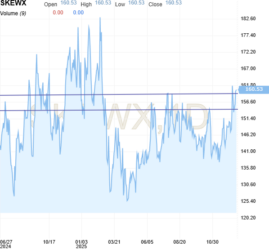Den seneste rapport fra den amerikanske centralbank, Fed, giver god indsigt i, hvordan centralbanken træffer beslutninger. Fed har hidtil villet vente med at sættge renten i vejret, indtil der igen var fuld beskæftigelse – “maksimal” beskæftigelse, som banken har udtrykt det. Det er der ikke endnu, da der er 3,5 millioner færre i beskæftigelse end før pandemien. Alligevel har Fed bebudet rentestigninger, ja, og desuden strammet kursen. Det skyldes den kraftige stigning i inflationen, og det får så centralbanken til at beskrive beskæftigelseshensynet lidt anderledes. Nu vil Fed ikke sige nøjagtigt, hvad fuld beskæftigelse er, men nøjes med at tale om retningen i beskæftigelsen, og den går altså opad. Inflationen kom som et chok for Fed, og derfor har centralbanken indtaget en mere fleksibel holdning til beskæftigelsen. At sikre en lav prisudvikling har fået førsteprioritet.
Fed’s ‘maximum employment’ is here; not everyone has benefited
Since adopting a new approach to U.S. monetary policy weighted towards ensuring a strong labor market, Federal Reserve officials have been reluctant to define key terms like “maximum employment,” arguing they did not want to prejudge how many jobs the economy could produce but feel their way toward that end.
They are hesitant no longer.
In two detailed paragraphs in the minutes of their Dec. 14-15 policy meeting, U.S. central bank officials declared the process all but complete. Over the course of 344 words, they ticked off a range of reasons for why the job market is “very tight” already and poised for “rapid progress” in covering any distance left to their maximum employment goal.
That would clear the way for the Fed to hike interest rates after pledging not to do so until maximum employment was assured.
But in the context of the discussion underway since the start of the coronavirus pandemic, when more than 22 million jobs disappeared in a collapse that fell heaviest on lower-income workers and racial and ethnic minorities, the minutes also showed the limits of how far the Fed is willing to go in ensuring the jobs recovery is “broad and inclusive” as well as complete.
Wages are rising, unemployment rates are falling across demographic groups, and the difficulties that remain in the job market, Fed officials said, had less to do with monetary policy and more to do with ongoing disruptions from COVID-19 – factors like school reopenings, child care and health conditions – that it cannot influence. Workers may take longer to be willing to take jobs again, they acknowledged, than had been expected.
GAPS REMAIN
Left unsaid was the fact that through November, some 3.5 million fewer people were working than in February of 2020, just before the pandemic, as measured by the Labor Department’s monthly survey of households, a gap Fed Chair Jerome Powell had all but promised would be erased. And the shortfalls are disproportionate among women and among the less educated.
The jobs recovery has also not been even geographically. Only about a dozen states – clustered in the Southeast and the Mountain West – have regained pre-pandemic levels of employment.
In the Northeast and through much of the industrial Midwest, employment in some states remains 5% or more below pre-pandemic peaks.
WHY THE RUSH?
The Fed’s heightened emphasis on jobs, adopted in August of 2020, was crafted at a moment when inflation was nonexistent – and had been for most of the previous decade. Officials were more convinced, at that point, that the central bank had erred in the past by not encouraging more job growth and instead had often raised interest rates even without a clear inflation risk.
The Fed was determined not to make that mistake again. But when inflation took off last year it became a potential constraint on the central bank’s ability to let the economy run unfettered.
Keeping prices under control is a core Fed objective. Now, even at the risk of slowing economic growth and hiring, the central bank feels it needs to be ready to tighten financial conditions or risk a worse and more persistent outbreak of price increases, an outcome that could prove equally harmful to the lower-income households disproportionately affected by pandemic-related job losses.
Just as the surge in inflation surprised the Fed, so did the behavior of workers, who did not flock into the record number of open positions at the pace expected.
The U.S. labor force participation rate is only slowly climbing back towards its pre-pandemic level, and some Fed officials are skeptical it will every fully recover. St. Louis Fed President James Bullard, for one, argues the participation rate should no longer be seen as unusually low given its prevailing downward trend over the previous two decades.
Moreover, there are now more than 1.5 jobs for every person declaring themselves unemployed – a record.
It is data like that which has brought the Fed close to declaring its work on the job front done. Though the remaining gaps are notable, even those who have followed the labor debate closest and pushed the central bank to be more aggressive on employment say officials may have a point.
If the job market in some parts of the country remains out of line, for example, there is not much Fed policy can do about it, and likewise if the virus is keeping workers reluctant to go back to their jobs.
“This has been a strange enough and big enough shock that they have to be more flexible,” said Josh Bivens, research director at the Economic Policy Institute. While Bivens said the Fed’s unwillingness to run a “hot” economy during the sluggish recovery from the 2007-2009 financial crisis and recession was “infuriating,” he agreed this time is different.
“I don’t think they are foreclosing the possibility that lots of jobs could come back,” Bivens said. “It is not the case, as in 2017, that all the risks are on one side. I always think inflation risk is overdone, but it is not zero anymore.”
Få de vigtigste finansnyheder direkte i indbakken. Tilmeld dig vores gratis nyhedsbrev om finans & økonomi her:
Tilmeld dig vores gratis nyhedsbrev
ØU Top100 Finansvirksomhed
Få de vigtigste om bank, realkredit, forsikring, pension
Udkommer hver mandag.




